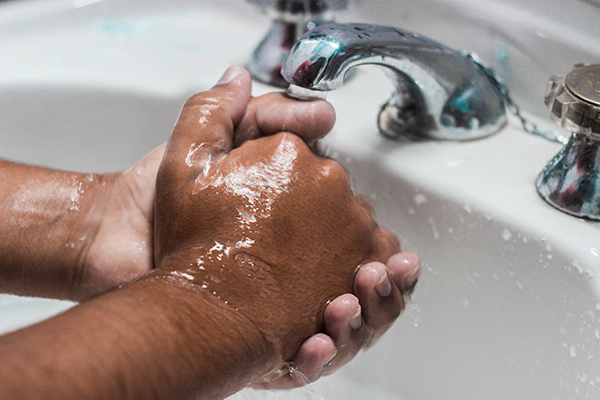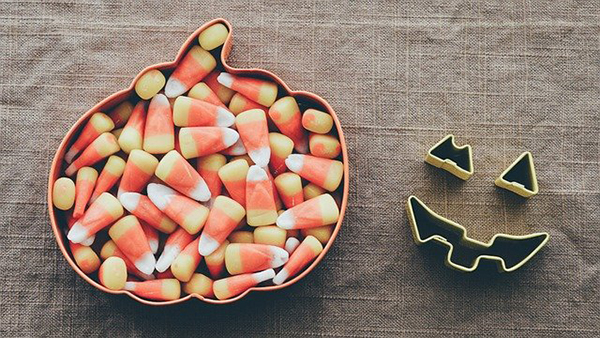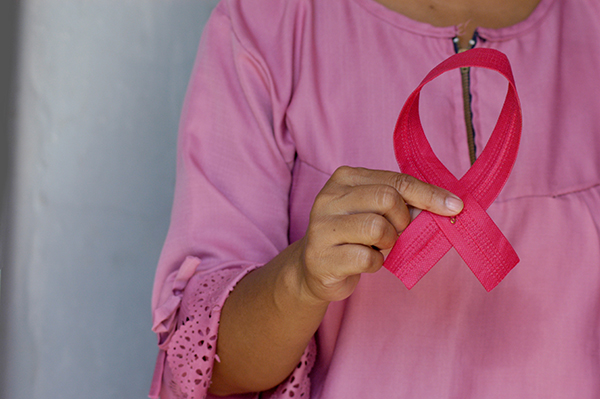Handwashing: Don’t Swish and Go!
 We have all watched someone quickly rinse their hands in a restroom and rush out the door—or skip the sink altogether. Body fluids and viruses are invisible to the naked eye, but these germs are everywhere. They contaminate commonly touched surfaces like handles, doors, walls, counters and paper dispensers.
We have all watched someone quickly rinse their hands in a restroom and rush out the door—or skip the sink altogether. Body fluids and viruses are invisible to the naked eye, but these germs are everywhere. They contaminate commonly touched surfaces like handles, doors, walls, counters and paper dispensers.
To help your family avoid the flu, there is no substitute for handwashing. Disposable hand wipes or gel sanitizers also work well, although they don’t remove dirt and grime.
Handwashing is one of the most effective ways to stop disease.
Wash your hands often: always before eating or preparing food, and always after using the bathroom or changing a diaper.
- Soap and water work well to kill germs. Rub your hands briskly.
- How long? At least 20 seconds—try humming “Happy Birthday” through twice.
- Most people miss the backs of the fingers and thumbs … fingertips … the creases in the palms.
- Use a paper towel to turn off faucets and to open the door.
With flu season here, give your hands the soapy wash they deserve. Take two minutes to safeguard your health—and wash your hands!
Halloween Tricks for Your Treats
By Christy Goff, Registered Dietitian
 Halloween night is exciting and fun … but then comes the sugar hangover the next day, week or even month! Let me share with you some tips and tricks for navigating that large pot of candy so you can have a healthier start to the holidays this year.
Halloween night is exciting and fun … but then comes the sugar hangover the next day, week or even month! Let me share with you some tips and tricks for navigating that large pot of candy so you can have a healthier start to the holidays this year.
1. Make a plan. Creating a plan with structure for you and your children keeps everyone on track. Some parents plan to indulge on Halloween night and then throw or give the rest away, while others put the candy bounty into plastic bags to have better portion control over the days that follow. Make your plan clear to your children as soon as you start talking about costumes and then stick to the plan throughout the holiday.
2. Always eat a balanced dinner before trick-or-treating. This will reduce the chance that hunger will dictate the amount of sweets you will indulge in later on.Teaching yourselves and children about balance while allowing room for treats is an important conversation to have throughout the whole year to maintain a positive relationship with food choices.
3. Understand portion sizes.Typically children should have no more than 1-2 pieces of candy per day and they should be given the candy with a meal to ensure the intake of healthy nutrients in addition. Even better, let them pick the meal they get to eat it at. Keep the candy in a special place so the kids can see it, but is not accessible easily, such as the top of the fridge or high counter. If there is just too much candy to manage, try using the rest as an art design, a lesson in sharing with others or throw it away.
4. Don’t deny treats or use them as a reward. Typically prohibiting treats or using them as a reward causes the desire for sweets to grow even more, especially if they are forced to do something they don’t want to do like clean, eat their veggies etc.Your child will to learn to manage sweets better if they are given in the same meal and treated the same as any other foods.Go back to your plan and decide what works best for your family to allow treats in moderation.
5. Enjoy the night! Focus on celebrating the holiday and spending time with family and friends.Remember that a balanced diet is created over time and all foods can be enjoyed in moderation, including treats.
For more information about Halloween treats and good health, visit the Ellyn Satter Institute.
Safety on Halloween Night
It’s a dark night, and groups of frantically excited kids in costumes are darting along sidewalks, bouncing off the curbs. They are excited to be hauling in candy. What could possibly go wrong?
Forget about vampires. You should be worried about cars. The Seattle Police Department recommends on its website that kids take flashlights out trick-or-treating. Remind your kids how tough it is for drivers to see at night, especially at dusk. And, of course, tell them not to weave between parked cars to get across the street. The candy will wait!
Make sure costumes are visible and that your child can see well. Make sure masks and big hair are clear of the eyes—and stay that way when jumping and running. Have a Batman, witch or other black-clad character in your group? Add a flashlight, glow sticks, glow jewelry or reflective tape.
Rethink trailing hemlines and large swords. They can be tripping hazards … and as the evening wears on, they aren’t much fun if your child is having trouble keeping up with friends! Warn your child, too, about candles in jack-o-lanterns. If costumes get too close, they can catch fire.
Keep big plastic bags away from small children who are out trolling for candy. If pulled over the face or head, they are a suffocation hazard. For treats, use a plastic pumpkin container or a cloth bag.
Nutrition for Cancer Prevention
According to the National Cancer Institute, dietary factors are thought to be the cause for about 30% of cancers in Western countries. Fortunately, diet is one of the cancer risk factors you have the power to alter. Read on to learn how foods in your daily diet can lower your potential risk of developing cancer.
Western countries have diets statistically high in animal products, fat and sugar—and also have high rates of colorectal, breast and prostate cancers, according to the National Institutes of Health. Being overweight or obese has also been seen to increase the risks of several common cancers. Nutrition guidelines for cancer prevention are similar to those for preventing other diseases such as heart disease and diabetes. Work with your primary care provider or a dietitian to gauge your overall dietary health.
Some nutrition and dietary factors to consider:
Fiber and other cancer-fighting nutrients. Studies show that fiber provides potential protective effects against cancer. While it is recommended to consume least 25-30 grams of fiber per day, the average U.S. citizen consumes only 10-15 grams. Fiber is found in vegetables, fruits, whole grains and legumes. Other cancer-fighting substances in fruits and vegetables include carotenoids; beta-carotene, vitamins C, E, K; folate; flavones and indoles.
Aim to fill half your plate with fruits and vegetables, and make at least half your grains whole grains. A diet rich in these plant-based foods can also help you stay at a healthy weight.
Fat intake. Recent studies show an excessive consumption of fat affects cancer risks. The average U.S. diet contains about 37 percent fat. While the National Cancer Institute suggests lowering your intake to 30 percent, other studies find that dropping fat consumption well below 30 percent may have an anti-cancer effect.
Reduce your intake of foods with added sugars and solid fats, which provide a lot of calories but few nutrients. These foods include sugar-sweetened beverages, processed snack foods and desserts.
Meat. Certain cooking and processing techniques of meats may lead to an increased cancer risk. The processes of smoking, salting, adding nitrates or related compounds, and cooking at high temperatures can convert meats into carcinogenic compounds within the colon.
Your best bet is to limit processed meats and instead include a variety of whole-food-based protein such as fish, skinless poultry and lean cuts of pork and beef. Consider eating plant-based sources of protein such as beans more often.
Alcohol. Excessive intake of alcohol raises one’s risks for cancers of the breast, mouth, pharynx and esophagus, as well as potential stomach, liver and colon cancers. It is considered more harmful when combined with smoking.
The Academy of Nutrition and Dietetics recommends limiting alcoholic drinks—if consumed at all—to one serving daily for women and two for men. (A serving of alcohol is considered 1½ fluid ounces of hard liquor, 5 fluid ounces of wine or 12 fluid ounces of beer.)
Designing a Breast Cancer Prevention Strategy
How often should you have a screening? What should your prevention strategy be? October is Breast Cancer Awareness month—a perfect time to talk with your provider about a strategy for you.
About one in eight U.S. women will develop invasive breast cancer, but due to great medical advances, around 80 percent will survive it. Still, breast cancer remains the second-deadliest cancer in women (after lung cancer). It is important to know your personal risk factors so you can take steps to reduce your risk.
Fortunately, this cancer is highly preventable. Read on for two important prevention steps. And of course, if you have questions, make an appointment with your primary care doctor to learn more.
Risk Factors
When deciding on your breast-cancer prevention and screening strategy, consider the following risk factors:
- Being female and older age
- Personal or family history of breast cancer, especially among close relatives
- Early onset of menstruation
- Later onset of menopause
- Dense breasts (as learned after a mammogram)
- History of breast health problems found in biopsies
Lifestyle factors play a moderate role in the development of breast cancer. Weight gain after menopause, working night shifts, alcohol use and several hormone-replacement therapies are known to increase the risk. On the other hand, having a baby before age 30, breastfeeding, regular exercise and a Mediterranean-like diet—rich in fruits, vegetables, fish and olive oil—all seem to aid in reducing the risk of developing breast cancer.
Screening
Despite the value of knowing your risks, many breast-cancer cases develop without obvious risk factors. This is why age-appropriate breast-cancer screenings are essential for all women.
The best approach to breast cancer detection is regular mammograms.
- Mammograms should be performed every 1-2 years beginning at age 40, based upon discussion with your provider.
- If you’re over age 75, the benefits of mammograms are less certain.
- Breast self-exams are a good practice. Knowing how your breasts normally look and feel can help you be aware of changes, which you can share with your healthcare provider. Finding a change doesn’t necessarily mean there is cancer.
If you have a family history, talk with your doctor about testing for hereditary cancer syndromes, such as BRCA gene mutations.
PacMed offers several options for primary care providers, an excellent place to begin a conversation about breast cancer prevention. Learn about our Primary Care team. We also invite you to explore our Women’s Health offerings and our Oncology department.
Anxiety rates among students rise as school year starts
 The first week of school is in the books for students in Western Washington. The beginning of the year can be a very exciting time for families, but it can also bring out anxiety in students.
The first week of school is in the books for students in Western Washington. The beginning of the year can be a very exciting time for families, but it can also bring out anxiety in students.
School counselors and psychotherapists say they see higher rates of anxiety as the school year gets started, especially among students in transitional grades like freshman in high school.
The sound of the school bell signals the start to a new school year, but for many students that sound also triggers anxiety.
“Anytime you have a transition it causes a lot of anxiety and stress,” said Ann McGowan, counselor with the Northshore School District.
She suggests parents check in with children not right after school, but after they’ve had some down time and ask them open ended questions for more elaborated answers.
“It gets you away from the “yes” or “nothing” or “no,” said McGowan.
She says parents can also focus on talking about school with conversations that center around fun times during the day which can draw out answers that can be telling about social issues or other problems children may be having.
“I try to talk about the open times during the day, so ‘Hey who did you hang out at recess?’ And, that helps create some other questions. ‘What was something funny your teacher did today,’” said McGowan. “If we don’t know, we can’t help,” she added.
A little anxiety on week one of the school year is normal, but McGowan said to pay close attention if it lasts too long.
“If we’re about three to four weeks in and they’re coming home every night and they’re tearful and upset,” she said that may be a cause for concern for some parents. She says many parents send her an email the night before if a child has had a particularly rough night and that can set up the child’s teacher and counselor with some preparation to assist the child during the following school day.
Psychotherapist Rene Czerwinski agrees with McGowan and says kids have a lot on their plates these days.
“I’ve been doing therapy for 18 plus years, and I do see younger and younger kids with anxiety,” said Czerwinski.
She says if a child shows dread going to school when in past years they’ve been excited, that might be a sign the anxiety is deeper than start of the school jitters. She adds children and teens with anxiety also tend to be extra fatigued, complain about stomach aches, headaches, are irritable, they may lash out at siblings or withdraw more from simple activities like calling friends on the phone or not eating very much. She says all of those indicate there may a deeper level of anxiety.
“Regular anxiety is when we’re supposed to have some fears that create a push to do things, and a persistent anxiety keeps us from doing things we would do otherwise,” she said.
Czerwinski suggests parents make sure they give undivided attention to children when they are having a conversation about anxiety or stress. She says turn off the television and get away from electronics that can be distracting. Czerwinski added if other siblings are going to be in the way, have a conversation with them first that you need a few minutes alone with their sibling. She says it’s important that parents validate the child’s feelings and it helps them open up more to parents.
Czerwinski says anxiety is common, and it’s not about getting rid of it but teaching children how they can cope with it.
“The idea is that we don’t want to save them from their fears and make them have no anxiety, if they don’t learn how to cope with it’s going to increase over time and it can be worse as adults and worse as they get older,” she said.
Czerwinski added that sports and extracurricular activities are often areas where some children who may not do well in school can flourish and a place where they can expand other social skills, but she says sometimes when children pull away from clubs like Girl Scouts or Boy Scouts, sports teams that parents should acknowledge there could be a deeper issue.
“When it starts affecting grades, when you notice they’re dropping. You know your child, you know what’s normal, so all of a sudden if they’re not eating anymore, they’re not calling their friends, if you have a teenager they may be in their room more often and avoiding other things, have the conversation, something else is going on,” said Czerwinski.
Czerwinski added for very young children a comfort box might be a good idea to help ease transitions. She said some parents put a stuffed animal, pictures, the child’s favorite toy or other items like they that can help anxiety.
McGowan said that schools now have a lot of transitional programs that help children through those grade changes that can be especially challenging. She stresses that parents shouldn’t be afraid to reach out to the school for help and that together they can help a child through anxiety and find methods to cope and make day-to-day school life more pleasant.
Staying Cool During Back-to-School
 PacMed doctor offers advice on easing back-to-school transition for kids
PacMed doctor offers advice on easing back-to-school transition for kids
As summer comes to an end, children and parents are hustling to complete last-minute tasks in preparation for the upcoming academic year. In the overwhelming whirlwind of purchasing supplies, completing physicals and reevaluating bedtimes, anxiety about returning to school may settle in for youngsters. Thankfully, Pacific Medical Centers’ psychotherapist in Behavioral Health, Rene Czerwinski, is here to offer expert insight on easing the transition from summer fun-in-the-sun to back-to-school cool.
Why do you think anxiety is a prevalent emotion felt by students as the new school year approaches?
Anxiety occurs for many different reasons and can vary for age groups. It includes worrying about whether a teacher will be strict, mean or friendly, how much homework will be given, how fellow classmates will behave, having classes with friends, having the “right” clothes and fitting in as well as concerns over making the sports team. All of these are normal worries for students returning to school.
What can parents and guardians do to prepare children for the upcoming school year in order to lessen these stressful feelings?
As a parent, friend or loved one, you can take several proactive steps to combat back-to-school anxiety and give children the confidence they need to excel in school. Patience is the number-one thing parents can start with for back-to-school anxiety. This includes helping your child set up a good routine for bedtime and establishing morning habits and other routines at least two weeks before school starts. Set up a regular time to discuss the day and if anything is troubling your child, and make sure to give them your undivided attention without any distractions. Validate your child’s concerns by letting them know they can talk to you and that you support them.
What advice can you offer children to manage overwhelming feelings of stress once the school year actually begins?
Sticking to a routine that includes staying on top of schoolwork and getting enough exercise can significantly reduce stress levels and feelings of anxiety. Children should also know that they can talk to their parents, guardian or a school counselor about how they’re feeling and know that they are supported.
What do you suggest for parents and children if anxious feelings outlast the initial first few weeks of school?
Once school starts and children fall into a new routine, monitor your child’s anxiety levels and behavior to determine if it improves or declines. Depending on the source of the anxiety and whether you believe it is temporary/circumstantial, it’s important to remember that behavioral health specialists can help with anxiety and depression.
Broccoli Apple Salad
 Broccoli is a popular vegetable for its versatility in main or side dishes and because it provides great health benefits for detoxifying the body. Try this version of broccoli salad with a healthy twist –a yogurt dressing!
Broccoli is a popular vegetable for its versatility in main or side dishes and because it provides great health benefits for detoxifying the body. Try this version of broccoli salad with a healthy twist –a yogurt dressing!
Four Health Issues That Embarrass Many Women
Some health topics can seem too embarrassing to talk about—even in the privacy of a doctor’s office. It’s understandable. Sharing personal information with a person you hardly know is bound to be unsettling.
Understand, however, that medical providers want to help you be healthy and happy. These are common issues, so you’re likely not the first person to raise them with your provider!
Urinary incontinence
Millions of women experience involuntary loss of urine. This is called urinary incontinence (UI). The severity of UI can vary anywhere from slightly bothersome to totally debilitating. Rather than avoid activities you love, speak with your medical provider! UI is a health problem that often can be helped through medication and muscle-strengthening exercises.
Urinary tract infections or UTIs
When bacteria get into your bladder or kidneys, it can cause a urinary tract infection. You may experience a burning sensation when urinating, frequent urges to urinate, pressure or pain, and discolored or odd-smelling urine. Your provider can treat you with antibiotics—and give you behavioral and dietary tips to help you avoid UTIs in the future.
Frequent urination
When frequent urination becomes a distraction in your life or prevents you from activities with family and friends, you should see your doctor. Many factors can contribute to this issue, such as too much caffeine, constipation, an unhealthy weight and smoking. But it’s wise to first begin with a visit to your health clinic; frequent urination can also be caused by a nerve signal or overactive bladder.
Contraception
A multitude of contraception methods is available today. Oral contraceptives, condoms, implants… All protect against pregnancy, but how do you know which one works best for you and your partner? By talking with your doctor, you can choose the method that’s right for you.
Two Steps to Help Prevent Cervical Cancer
Human papillomavirus, better known as HPV, is the main cause of cervical cancer. It is also the most common sexually transmitted virus in the United States. The HPV vaccine protects against the types of HPV that most often cause cervical cancer.
When detected early, cervical cancer is highly curable. But the cancer in its early stages may have no signs or symptoms. This is why regular screening is so important.
Get Vaccinated! The HPV Vaccine
HPV vaccination is recommended for:
- Preteen girls and boys ages 11 and 12.
- Women ages 13 through 26 who haven’t been vaccinated yet or have not completed the vaccine series.
Get Screened! The Pap Test
Regular screening, also called a Pap test, is recommended for:
- All women aged 21 to 65 (including women who got the HPV vaccination)












